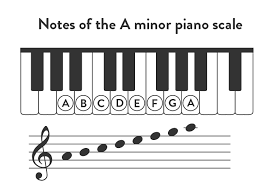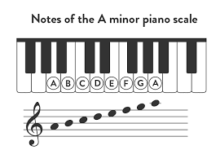A Minor Notes: What They Are and How to Play Them on Piano Easily

When someone says “a minor notes,” they are talking about the group of sounds that belong to the A minor scale. This scale is made up of seven notes: A, B, C, D, E, F, and G. These notes are all natural, which means they don’t have sharps or flats. A minor notes are easy to learn because they use only the white keys on a piano. If you’re new to music or just starting to play piano, the A minor notes are a great place to begin. They sound soft, a little sad, and very calm — that’s the special feel of the A minor scale.
The A minor scale is also very important because it helps build many songs and chords. It is closely connected to the C major scale — they share the same notes, just starting from a different place. That’s why they are called “relatives” in music theory. Knowing the A minor notes can help you play popular songs, understand chords, and make your own music too. Whether you want to write a melody, play background music, or just have fun with the piano, learning these notes will help you a lot. As you go on, you’ll see how these simple notes can sound really beautiful together.
What Are A Minor Notes? A Simple Explanation for Beginners
A minor notes are a group of music notes that belong to the A minor scale. These notes are A, B, C, D, E, F, and G. All of them are white keys on the piano. There are no sharp (#) or flat (b) notes in this group, which makes it easy for beginners. A minor notes are used in many songs and sound soft and a little sad. They are called “natural notes” because they don’t change. If you play them one after the other on the piano, they make a nice melody. People who are learning music often start with the A minor scale because it’s simple and sounds lovely. These notes are also used to make chords and help build songs. So, if you know A minor notes, you can start playing and making your own music right away.
Why A Minor Notes Are Easy for Piano Learners
A minor notes are great for beginners because they use only the white keys on the piano. That means you don’t have to worry about black keys, sharps, or flats. This makes learning faster and less confusing. You can play the A minor scale by starting at A and going up through B, C, D, E, F, and G. Once you reach G, you start again at A. Because all the notes are natural, you can focus more on finger movements and rhythm. Also, since A minor and C major share the same notes, when you learn one, you kind of learn both! It’s like a two-in-one lesson. These notes are simple but can still make beautiful music. That’s why many music teachers and online videos suggest starting with A minor. It’s a small step, but a strong start in music.
A Minor Notes on the Piano: Where to Find Them
Finding A minor notes on the piano is easy! Just look for the white key labeled “A” and start there. Then, play the next white keys in order: B, C, D, E, F, and G. These seven notes are the full A minor scale. You will notice that none of these are black keys. That’s because A minor has no sharps or flats. It’s all white keys from A to G. If you want to play them going up (ascending), just press each white key from A to the next A higher up. To play them going down (descending), do the same but backwards. You can use your fingers one by one and get a feel for how the notes sound. Practicing these keys will help you build finger strength and learn patterns. With time, your hands will move smoothly across the keys
How A Minor Notes Sound and Why They Feel Sad
A minor notes sound soft, calm, and a little bit sad. This is because of how the notes are spaced from each other. Music made with A minor notes often gives a feeling of quiet or deep thinking. Some people say it sounds emotional. That’s what makes it different from happy-sounding major notes. A minor notes are often used in slow songs, movie music, or calm background sounds. If you play them slowly on the piano, you might even feel relaxed or thoughtful. The sound isn’t scary — just gentle and moody. Even though they sound a bit sad, you can still make pretty and peaceful songs with them. So, don’t worry! Sad doesn’t mean bad. Many beautiful songs use A minor notes. Once you start playing with them, you’ll see how many feelings you can share just by using your fingers.
A Minor Notes vs. C Major Notes: What’s the Difference?
A minor and C major use the exact same notes: A, B, C, D, E, F, and G. But they sound different because they start from different places. C major starts on the note C and sounds happy and bright. A minor starts on the note A and sounds soft and a little sad. Think of it like telling a story using the same words, but changing the mood. That’s what happens when you change the starting note in a scale. The pattern of strong and weak sounds (called intervals) is also different. Even though the notes are the same, A minor gives you a whole new feeling. This is why learning both can help you understand music better. If you already know one, the other will be easier to learn. It’s like learning two styles with one set of tools.
Chords Made from A Minor Notes You Can Play Today
You can build many simple chords using A minor notes. A chord is just a group of notes played at the same time. Start with the A minor chord, which uses A, C, and E. This is called the “i” chord in the A minor scale. Next, try the D minor chord using D, F, and A — that’s the “iv” chord. Another easy one is the E minor chord (E, G, B). You can also try C major (C, E, G), F major (F, A, C), and G major (G, B, D). These are all made using only A minor notes, so you don’t need to learn new ones yet. Playing these chords will help you create songs, background music, or just nice-sounding patterns. Try pressing the keys together slowly, and listen to how they blend. These chords are a fun way to explore music and build skills.
Conclusion
A minor notes are simple, soft, and easy to learn. If you’re just starting your piano journey, they are a great place to begin. They use only white keys, which means you can focus on playing without getting lost. Plus, they sound peaceful and are used in lots of music around the world.
You don’t need to know hard theory or play fast to enjoy A minor notes. Just a little practice every day can help you feel the music and even write your own. Keep going, keep playing, and most of all — have fun! Music is a journey, and A minor is a great first step.
FAQs
Q: What are the notes in A minor?
A: The notes in A minor are A, B, C, D, E, F, and G.
Q: Are there any sharp or flat notes in A minor?
A: No, A minor has all natural notes — no sharps or flats.
Q: What chord can I play with A minor notes?
A: You can play chords like A minor, D minor, E minor, C major, and F major.
Q: Is A minor the same as C major?
A: They use the same notes but sound different. A minor sounds sad; C major sounds happy.
Q: Is A minor good for beginners?
A: Yes! It’s perfect for beginners because it uses only white keys on the piano.

